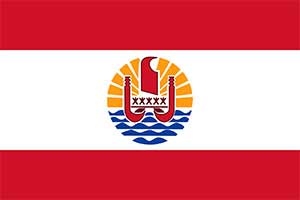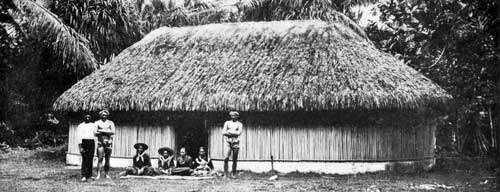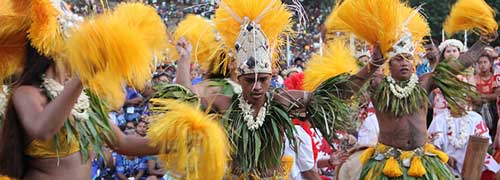Map
Flag

Quick facts
Official Name: French Polynesia
Indigenous Peoples: Maohi (Tahitians)
Official Languages: Tahitian, French
Political Status: Semi-autonomous French territory
Capital: Pape’ete
Population: 268,270 (2012 est.)
Greeting: La ora na
History and geography

The islands of French Polynesia make up a total land area of 3,521 sq km (1,359 sq mi), scattered over more than 2,000 km (1,200 mi) of ocean in the South Pacific. French Polynesia is divided into five groups of islands: The Society Islands archipelago composed of the Windward Islands and the Leeward Islands; the Tuamotu Archipelago; the Gambier Islands; the Marquesas Islands; and the Austral Islands. Among its 118 islands and atolls, 67 are inhabited. Tahiti, in the Society Islands, is the most populous island and the seat of the capital of the collectivity, Pape’ete. About 68% of the population of the islands lived in Pape’ete in 2012. Although not an integral part of its territory, Clipperton Island was administered from French Polynesia until 2007. The highest point of French Polynesia is Mount Orohena in Tahiti.
French Polynesia was one of the last places in the Pacific to be settled. Scientists believe the Great Polynesian Migration happened around 1500 BC. The first islands of French Polynesia to be settled were the Marquesas Islands about 200 BC. The Polynesians later discovered the Society Islands around 300 AD.
Portuguese explorer Ferdinand Magellan sighted one of the islands on his voyage around the world in 1521, beginning a long history of European interaction with Polynesia.
French Polynesians were first granted French citizenship in 1946 when the islands’ status was changed to an overseas territory. The islands’ name was changed in 1957 to Polynésie Française (French Polynesia). French Polynesia was granted partial internal autonomy in 1977 which was extended in 1984. French Polynesia became a full overseas collectivity of France in 2003.
Tourism is the main economic industry. Additionally, Tahitian pearl farming is a good source of export revenue. The islands also export vanilla, fruits, flowers and other natural products. French Polynesia has a moderately developed economy based on tourism and support from France.
Arts and culture

Much of traditional Polynesian culture and arts, such as dancing (tamure), music, tattooing, and religion, disappeared in large part under the influence of Christian missionaries in the late 18th century. The beauty of the islands drew artists such as the French painter Paul Gaugin, who lived first in Tahiti. Gauguin painted Polynesian images and spiritual themes into his work, and some of his paintings, as well as the works of other artists, are displayed in the Paul Gauguin Museum on Tahiti.
Greater attention is being paid to Polynesian culture with the advent of tourism, including the increased use of the Tahitian language and its elevation to the status of an official language in the late 20th century. An ethnographic museum and learned society in Pape’ete have contributed to efforts to preserve French Polynesia’s cultural heritage.
Polynesian delegations
- American Samoa
- Cook Islands
- Easter Island (Rapa Nui)
- French Polynesia (Tahiti)
- Hawai’i
- New Zealand (Maori)
- Niue
